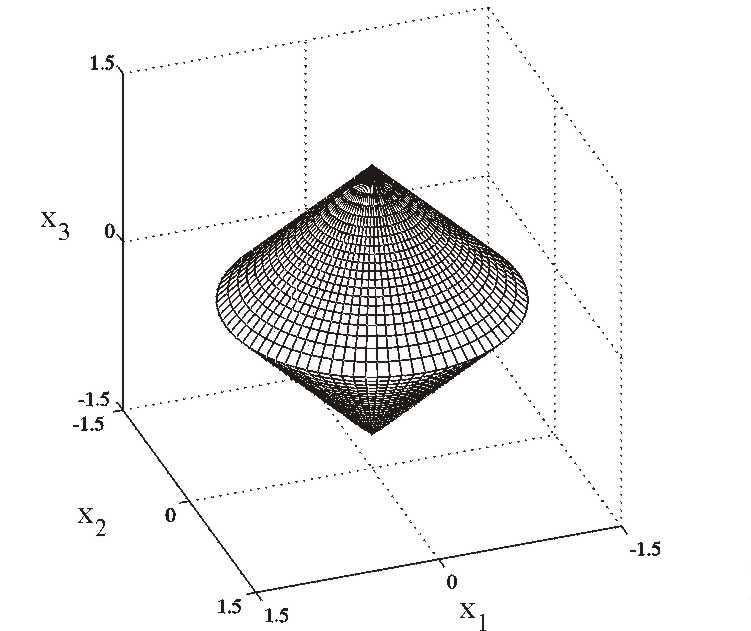Experiment 1
The setting of the experiment consists of:
- i) The scatterer W: The double cone is made of a couple of cones
of the same size placed one upon the other with the bases in common. The height
of the cones is equal to 1.2 and the basis is a circle contained in the
x3=0-plane of radius 1.2 and center the origin (see Figure 1).
The impedance is chosen equal to zero, i.e. the obstacle is acoustically soft.
Figure 1

- ii) The mask D (Animation 1): The mask is a sphere of center the origin
and radius 0.5. We choose its impedance as
c¢ = +¥
(Animation 1).
- iii) The incoming wave: We consider an incoming wave packet given by:
|
ui(
x,t) = e-[
(g,
x)-ct]2/4z2, (
x,t) Î R3×R, |
(1.1) |
|
where
c=1,
g = (0,0,-1)T, z = 0.5.
We approximate the wave scattered by the active obstacle uas, by the passive
obstacle ups and the auxiliary variable j
with a superposition of time harmonic waves, that is:
|
uas(
x,t) = |
1
p0.5
|
|
N1
å
i = 1
|
aie-iwi t usa,wi/z,
g(
x), (
x,t) Î (R3\ |
W
|
)×R, | (1.2) |
|
|
ups(
x,t) = |
1
p0.5
|
|
N1
å
i = 1
|
aie-iwi t usp,wi/z,
g(
x), (
x,t) Î (R3\ |
W
|
)×R, | (1.3) |
|
|
j(
x,t) = |
1
p0.5
|
|
N1
å
i = 1
|
aie-iwi t jwi/z,
g(
x), (
x,t) Î (R3\ |
W
|
)×R, | (1.4) |
|
where wi,
i = 1,2,¼,N1 are the zeros of the Hermite polynomial of
degree N1 and ai, i = 1,2,¼,N1 are the weights of
the Gauss-Hermite quadrature rule. We choose N1=400.
The following animation
shows from left to right the incoming field going through the obstacle
W, the corresponding
field scattered by the mask, by the active obstacle and by the
passive obstacle.
The incoming field and the scattered fields are represented in the
following color scale:

The animation shows that the passive obstacle responds with a sizable
reaction to the incoming field
earlier than the active obstacle. This is a consequence of the fact that
the active obstacle tries to reproduce the behaviour of the mask. In fact
the mask is "contained" in the obstacle
hence the incoming field hits the mask "later"
than the obstacle.
Furthermore, the animation shows a very different behaviour between the active and the
passive obstacle. In particular when the active obstacle is beginning to respond
with a sizable reaction the wave scattered is of positive sign and
is concentrated around the x3=0 plane that is around
the plane containing the basis of the cones. In fact in this case the active obstacle
tries to react as an acoustically hard sphere. When the incoming
wave is going through the active obstacle the real nature
of this obstacle appears and the vertices of the cones begin to react with
a positive scattered field. However the intensity of this field
is smaller than the intensity of the field scattered by the passive obstacle
in the same circumstances.


